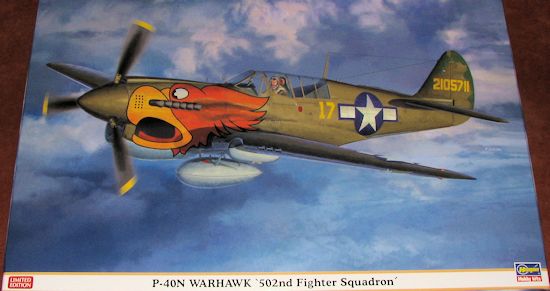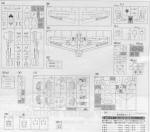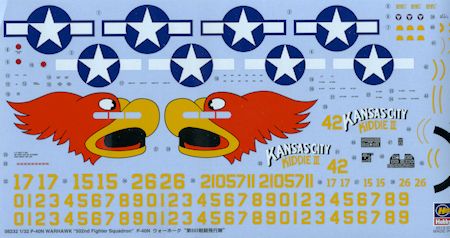
Hasegawa 1/32 P-40N Warhawk '502nd Fighter Squadron'
| KIT #: | 08232 |
| PRICE: | 3680 yen (about $38.00) discounted at Hobby Link Japan (4600 yen SRP) |
| DECALS: | Two options |
| REVIEWER: | Scott Van Aken |
| NOTES: | Limited Reissue |

| HISTORY |
The Curtiss P-40 Warhawk was an American single-engine, single-seat, all-metal fighter and ground attack aircraft that first flew in 1938. The P-40 design was a modification of the previous Curtiss P-36 Hawk which reduced development time and enabled a rapid entry into production and operational service. The Warhawk was used by most Allied powers during World War II, and remained in front line service until the end of the war. It was the third most-produced American fighter, after the P-51 and P-47; by November 1944, when production of the P-40 ceased, 13,738 had been built, all at Curtiss-Wright Corporation's main production facilities at Buffalo, New York.
Warhawk was the name the United States Army Air Corps adopted for all models, making it the official name in the United States for all P-40s. The British Commonwealth and Soviet air forces used the name Tomahawk for models equivalent to the P-40B and P-40C, and the name Kittyhawk for models equivalent to the P-40D and all later variants.
P-40s first saw combat with the British Commonwealth squadrons of the Desert Air Force in the Middle East and North African campaigns, during June 1941. No. 112 Squadron Royal Air Force, was among the first to operate Tomahawks in North Africa and the unit was the first Allied military aviation unit to feature the "shark mouth" logo, copying similar markings on some Luftwaffe Messerschmitt Bf 110 twin-engine fighters.
The P-40's lack of a two-stage supercharger made it inferior to Luftwaffe fighters such as the Messerschmitt Bf 109 or the Focke-Wulf Fw 190 in high-altitude combat and it was rarely used in operations in Northwest Europe. Between 1941 and 1944, the P-40 played a critical role with Allied air forces in three major theaters: North Africa, the Southwest Pacific and China. It also had a significant role in the Middle East, Southeast Asia, Eastern Europe, Alaska and Italy. The P-40's performance at high altitudes was not as important in those theaters, where it served as an air superiority fighter, bomber escort and fighter bomber. Although it gained a post-war reputation as a mediocre design, suitable only for close air support, recent research including scrutiny of the records of individual Allied squadrons, indicates that the P-40 performed surprisingly well as an air superiority fighter, at times suffering severe losses but also taking a very heavy toll of enemy aircraft. The P-40 offered the additional advantage of low cost, which kept it in production as a ground-attack aircraft long after it was obsolete as a fighter. In 2008, 29 P-40s were airworthy.
The P-40N (manufactured 1943–44), the final production model. The P-40N featured a stretched rear fuselage to counter the torque of the larger, late-war Allison engine, and the rear deck of the cockpit behind the pilot was cut down at a moderate slant to improve rearward visibility. A great deal of work was also done to try and eliminate excess weight to improve the Warhawk's climb rate. Early N production blocks dropped a .50 in (12.7 mm) gun from each wing, bringing the total back to four; later production blocks reintroduced it after complaints from units in the field. Supplied to Commonwealth air forces as the Kittyhawk Mk IV. A total of 553 P-40Ns were acquired by the Royal Australian Air Force, making it the variant most commonly used by the RAAF. Sub-variants of the P-40N ranged widely in specialization from stripped down four-gun "hot rods" that could reach the highest top speeds of any production variant of the P-40 (up to 380 mph), to overweight types with all the extras intended for fighter-bombing or even training missions. The 15,000th P-40 was an N model decorated with the markings of 28 nations that had employed any of Curtiss-Wright's various aircraft products, not just P-40s. "These spectacular markings gave rise to the erroneous belief that the P-40 series had been used by all twenty-eight countries."
| THE KIT |
 Hasegawa
is probably the king of limited reissue kits and so has added another P-40 kit
to their growing Warhawk repertoire. This one is the P-40N and so has all the N
model features of an extended fuselage, cooling grilles in the nose, modified
rear canopy section and the spoked wheels so often seen on these planes.
Hasegawa
is probably the king of limited reissue kits and so has added another P-40 kit
to their growing Warhawk repertoire. This one is the P-40N and so has all the N
model features of an extended fuselage, cooling grilles in the nose, modified
rear canopy section and the spoked wheels so often seen on these planes.
If you have built any of the previous 1/32 scale Warhawk kits, you will find an old friend. The kit has a vary nicely done cockpit with a properly curved floor, 'wing' armor plating for the seat, rudder pedals, flap handle, control stick, instrument panel and gun sight. The sidewalls have good detail with a number of additional bits to attach to them. I am sure a resin aftermarket cockpit has finer detail, but for most of us, what comes in the kit will be more than sufficient. Decals are provided for instruments should you wish to use them.
A detailed nose radiator assembly is included to fit into the forward fuselage. The kit also has the proper exhaust panel that will fit the individual 'fishtail' exhaust that were the norm for this version. The forward intake cooling plates are also provided. This kit has a separate rear fuselage section to take care of the different variants. In this case, it is the longer fuselage that all N versions used. This has a separate rudder though the elevators are not. Wings have nicely done seven piece wheel well inserts as well as inserts for the guns that place them properly just below the wing centerline.
On the underside you have a set of lower radiator cooling gills with actuating levers. A centerline rack can be used for either a drop tank or a bomb as you chose. There are decal stripes for the bomb, which is nice as many of us suck at painting these items. Diamond tread tires are provided for the very detailed landing gear assembly. Hasegawa likes to include a pilot for its big scale planes and this one is no different, though few US modelers will end up using it. Clear bits are nicely molded and there are separate sliding canopy sections for open and closed canopy. From what I gather, there should be a bar running down the centerline of the sliding canopy and this is not engraved on the part. I do like that the windscreen is molded with the fuselage section right in front of it so that should make it easier to install. A single piece prop is included, which gets away from the separate prop blades that many of us are less than thrilled about.
An additional option is the ability to cut off all the formation lights from the wings and tail and replace them with small clear bits. This is nice to have, but I know I'll lose at least one in construction so generally leave these off.
Instructions use Gunze paint references and provide
two markings options, both in a base of olive drab over neutral grey. The box
art plane with the huge parrot nose is from a training unit in Florida, the
502FS/3 37 FG
in Florida during 1944. This aircraft has medium green splotches along the edges
of the fin/rudder and ratiling edge of the wings. THe other is a white tailed
plane from the 8th FS/49th FG in 1943. This plane is called 'Kansas City Kiddie
III' and has the white on the fin/rudder and the underside of the tailplanes.
The spinner is yellow with a black stripe. The decal sheet is very large, being
a bit too large for the platen of my scanner. It is very nicely printed with
properly white whites. It also seems to have additional fuselage numbers for the
box art plane, though no indication of what the additional serial numbers might
be. However, there are a nice selection of separate serial numbers so you can
make up your own.
37 FG
in Florida during 1944. This aircraft has medium green splotches along the edges
of the fin/rudder and ratiling edge of the wings. THe other is a white tailed
plane from the 8th FS/49th FG in 1943. This plane is called 'Kansas City Kiddie
III' and has the white on the fin/rudder and the underside of the tailplanes.
The spinner is yellow with a black stripe. The decal sheet is very large, being
a bit too large for the platen of my scanner. It is very nicely printed with
properly white whites. It also seems to have additional fuselage numbers for the
box art plane, though no indication of what the additional serial numbers might
be. However, there are a nice selection of separate serial numbers so you can
make up your own.
| CONCLUSIONS |
If you have not yet purchased one of these very nice big scale Hasegawa Warhawk kits, this would be a good one for you. It has very colorful markings and like all newer Hasegawa kits, will be a pleasant build.
| REFERENCES |
http://en.wikipedia.org/wiki/P-40N_Warhawk
March 2013 Thanks to
Hobby Link Japan
for the preview kit. Get yours at the link. If you would like your product reviewed fairly and fairly quickly, please contact the editor or see other details in the
Note to
Contributors.